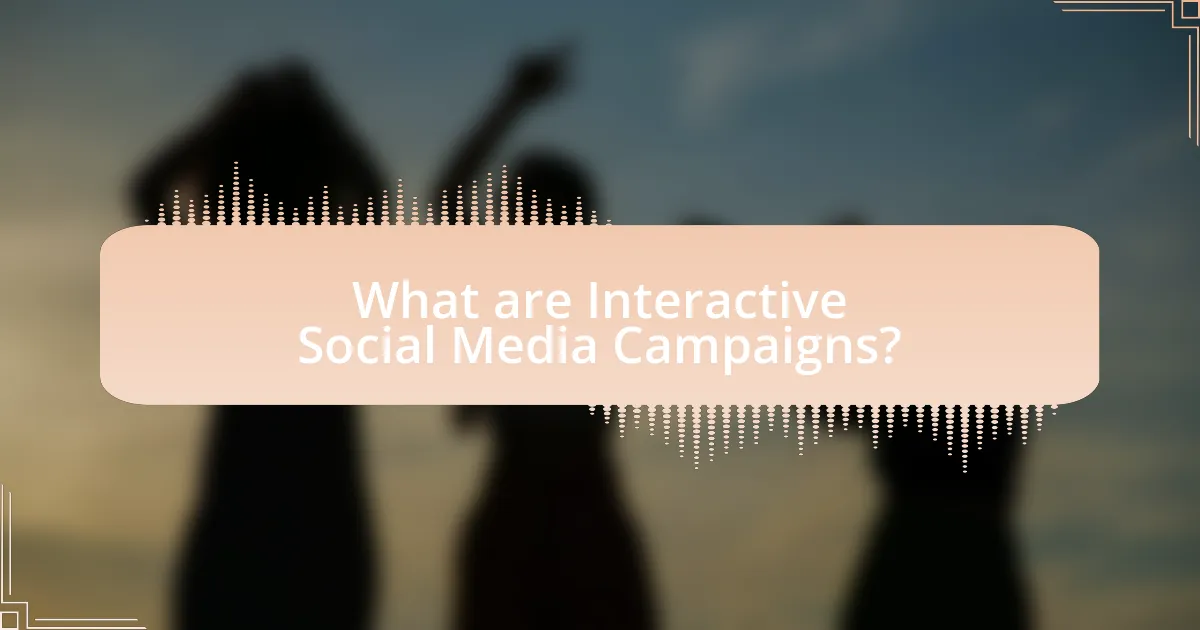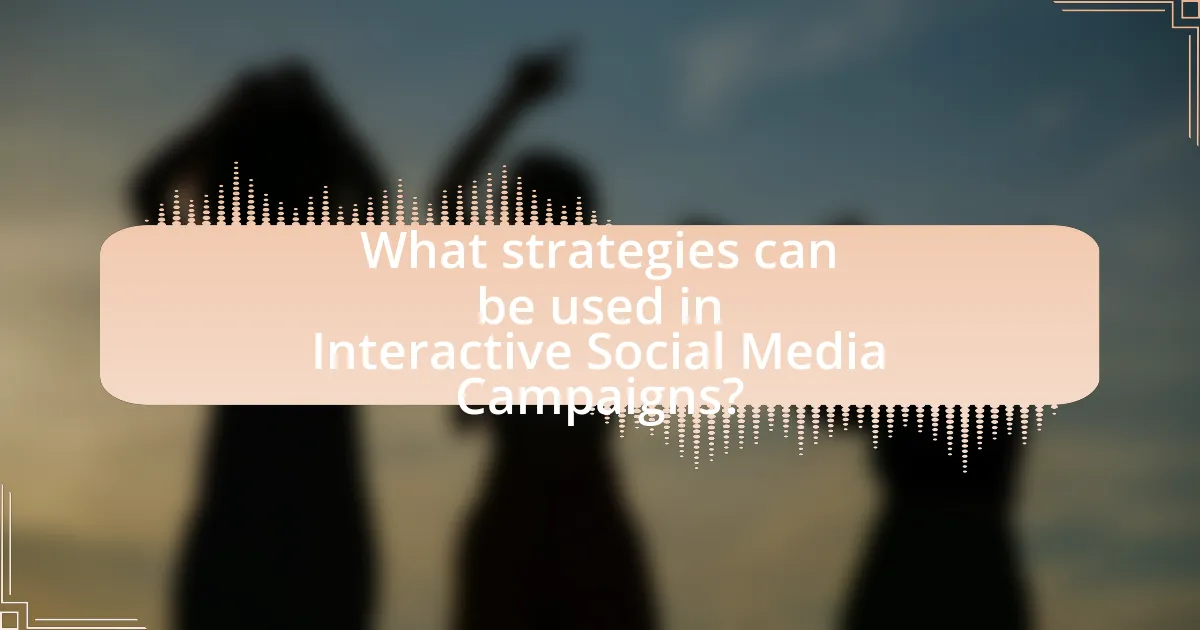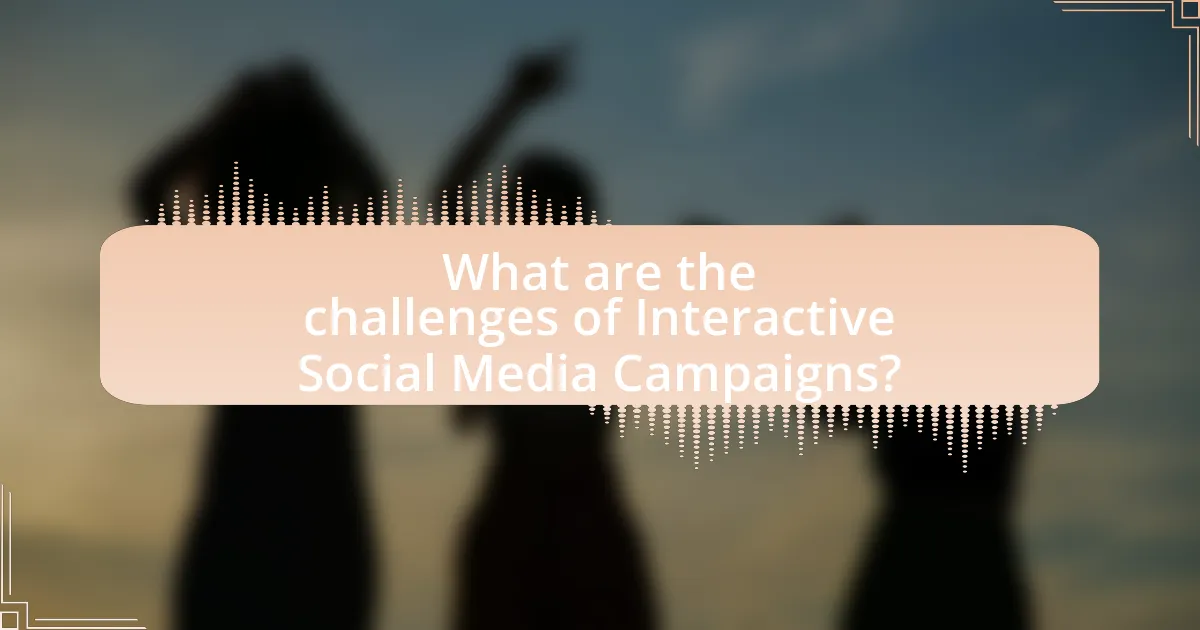Interactive social media campaigns are marketing strategies designed to actively engage users through participation and interaction, utilizing tools such as polls, quizzes, contests, and user-generated content. These campaigns enhance fan engagement by fostering two-way communication, which can significantly increase brand loyalty and awareness. Key strategies for successful campaigns include understanding the target audience, creating compelling content, and maintaining authenticity. Additionally, brands can measure the effectiveness of these campaigns through analytics tools, while also addressing challenges such as content saturation and audience feedback. Overall, interactive social media campaigns are essential for brands seeking to build strong relationships with their audience and drive conversions.

What are Interactive Social Media Campaigns?
Interactive social media campaigns are marketing strategies that actively engage users through participation and interaction. These campaigns often utilize features such as polls, quizzes, contests, and user-generated content to foster a two-way communication channel between brands and their audience. For instance, a study by the Content Marketing Institute found that interactive content can generate up to 2 times more conversions than passive content, highlighting its effectiveness in capturing audience attention and driving engagement.
How do Interactive Social Media Campaigns engage fans?
Interactive social media campaigns engage fans by fostering two-way communication and encouraging active participation. These campaigns utilize features such as polls, quizzes, and user-generated content to create an immersive experience, allowing fans to express their opinions and creativity. For instance, a study by the Pew Research Center found that 69% of adults in the U.S. use social media, indicating a vast audience that can be reached through interactive elements. By involving fans in the content creation process, brands can enhance loyalty and emotional connection, as evidenced by campaigns that have successfully increased engagement rates by over 50% when fans are invited to contribute ideas or vote on outcomes.
What types of interactions can be included in these campaigns?
Interactive social media campaigns can include various types of interactions such as polls, quizzes, contests, user-generated content, and live Q&A sessions. Polls and quizzes engage users by allowing them to express their opinions or test their knowledge, while contests encourage participation through competition, often incentivized by prizes. User-generated content invites fans to share their own creations, fostering a sense of community and involvement. Live Q&A sessions provide real-time interaction, allowing fans to ask questions and receive immediate responses, enhancing engagement. These interaction types are effective in building relationships and increasing brand loyalty among fans.
How do these interactions enhance fan experience?
Interactions through interactive social media campaigns enhance fan experience by fostering a sense of community and personal connection. These campaigns allow fans to engage directly with their favorite teams or artists, creating opportunities for real-time feedback and participation. For instance, studies show that 70% of fans feel more connected to a brand when they interact with it on social media, highlighting the importance of these interactions in building loyalty and engagement. Additionally, interactive elements such as polls, contests, and live Q&A sessions provide fans with a platform to express their opinions and feel valued, further enriching their overall experience.
Why are Interactive Social Media Campaigns important for brands?
Interactive social media campaigns are important for brands because they enhance customer engagement and foster a sense of community. By encouraging participation through polls, contests, and user-generated content, brands can create a two-way communication channel that strengthens relationships with their audience. According to a study by Sprout Social, 70% of consumers feel more connected to brands with which they can interact. This connection leads to increased brand loyalty and higher conversion rates, as engaged customers are more likely to make purchases and advocate for the brand.
What benefits do brands gain from engaging fans through these campaigns?
Brands gain increased customer loyalty and enhanced brand awareness by engaging fans through interactive social media campaigns. Engaging fans fosters a sense of community and belonging, which can lead to repeat purchases and long-term relationships. According to a study by Sprout Social, 64% of consumers want brands to connect with them on social media, indicating that active engagement can significantly boost brand visibility and customer retention. Additionally, interactive campaigns often generate user-generated content, which can further amplify brand reach and authenticity, as seen in successful campaigns like Coca-Cola’s “Share a Coke.”
How do these campaigns impact brand loyalty and awareness?
Interactive social media campaigns significantly enhance brand loyalty and awareness by fostering direct engagement between brands and consumers. These campaigns create a two-way communication channel, allowing brands to connect with their audience on a personal level, which increases emotional attachment and trust. For instance, a study by the American Marketing Association found that brands utilizing interactive content saw a 70% increase in customer engagement, leading to higher retention rates. Additionally, according to a report by HubSpot, 54% of consumers prefer brands that engage with them on social media, indicating that such campaigns not only raise awareness but also cultivate a loyal customer base.

What strategies can be used in Interactive Social Media Campaigns?
Interactive social media campaigns can utilize strategies such as user-generated content, polls and surveys, live Q&A sessions, and gamification. User-generated content encourages fans to create and share their own content related to the brand, fostering community engagement and authenticity. Polls and surveys allow brands to gather insights while involving their audience in decision-making, enhancing participation. Live Q&A sessions create real-time interaction, allowing fans to connect directly with the brand or influencers, which can increase loyalty. Gamification introduces elements of competition and rewards, motivating users to engage more deeply with the campaign. These strategies have been shown to increase engagement rates significantly, with studies indicating that campaigns incorporating user-generated content can see up to a 28% increase in engagement compared to traditional marketing methods.
How can brands create compelling content for these campaigns?
Brands can create compelling content for interactive social media campaigns by focusing on authenticity, storytelling, and audience engagement. Authenticity builds trust; for instance, 86% of consumers say that authenticity is important when deciding what brands they like and support. Storytelling captivates audiences; brands that tell relatable stories can increase engagement rates significantly. Additionally, incorporating interactive elements such as polls, quizzes, and user-generated content fosters participation, leading to a 70% increase in engagement according to studies by HubSpot. By combining these strategies, brands can effectively engage their audience and enhance the impact of their campaigns.
What role does storytelling play in engaging fans?
Storytelling plays a crucial role in engaging fans by creating emotional connections and enhancing their overall experience. When brands or creators share narratives that resonate with their audience, they foster a sense of belonging and loyalty. For instance, research by the Harvard Business Review indicates that storytelling can increase audience retention by up to 65%, as stories are more memorable than facts alone. This emotional engagement encourages fans to participate actively, share content, and develop a deeper relationship with the brand or creator.
How can visuals enhance the effectiveness of the campaign?
Visuals can enhance the effectiveness of a campaign by capturing attention and conveying messages quickly and clearly. Research indicates that content with relevant images receives 94% more views than content without images, demonstrating the significant impact visuals have on engagement. Additionally, visuals can evoke emotions and create a memorable experience, which is crucial in social media campaigns aimed at fan interaction. For instance, studies show that people remember 80% of what they see and do, compared to only 20% of what they read. This ability to enhance recall and emotional connection makes visuals a powerful tool in driving campaign success.
What tools and platforms are best for executing these campaigns?
The best tools and platforms for executing interactive social media campaigns include Hootsuite, Buffer, and Sprout Social. Hootsuite allows users to manage multiple social media accounts, schedule posts, and analyze performance metrics, making it ideal for campaign execution. Buffer offers similar functionalities with a focus on scheduling and analytics, enabling teams to optimize their content strategy effectively. Sprout Social provides robust engagement tools and reporting features, which help in understanding audience interactions and refining campaign approaches. These platforms are widely recognized for their effectiveness in enhancing social media engagement and campaign management.
Which social media platforms are most effective for fan engagement?
The most effective social media platforms for fan engagement are Instagram, Facebook, and Twitter. Instagram excels in visual content, allowing brands to share images and videos that resonate with fans, leading to higher interaction rates; studies show that posts with images receive 650% more engagement than text-only posts. Facebook offers diverse content formats and community-building features, with 1.8 billion users engaging daily, making it ideal for fostering fan communities. Twitter facilitates real-time interaction and trending topics, with 80% of users feeling more connected to brands that engage with them on the platform. These platforms collectively enhance fan engagement through their unique features and large user bases.
How can analytics tools measure the success of these campaigns?
Analytics tools measure the success of interactive social media campaigns by tracking key performance indicators (KPIs) such as engagement rates, conversion rates, and reach. These tools analyze metrics like likes, shares, comments, and click-through rates to assess audience interaction and content effectiveness. For instance, a study by HubSpot found that campaigns with higher engagement rates typically lead to increased brand awareness and customer loyalty, demonstrating a direct correlation between social media activity and campaign success. Additionally, tools like Google Analytics can provide insights into user behavior and demographics, allowing marketers to refine their strategies based on data-driven results.

What are the challenges of Interactive Social Media Campaigns?
Interactive social media campaigns face several challenges, including audience engagement, content saturation, and measuring effectiveness. Audience engagement can be difficult due to the vast amount of content available, leading to competition for attention. Content saturation occurs when users are overwhelmed by similar messages, making it hard for campaigns to stand out. Additionally, measuring the effectiveness of these campaigns can be complex, as traditional metrics may not fully capture user interactions and sentiment. According to a study by the Content Marketing Institute, 70% of marketers struggle to measure the ROI of their social media efforts, highlighting the need for better analytics tools to assess campaign success.
What common pitfalls should brands avoid?
Brands should avoid inconsistent messaging, as it can confuse audiences and dilute brand identity. Consistency in tone, visuals, and values across all platforms reinforces brand recognition and trust. For instance, a study by the Content Marketing Institute found that 60% of consumers prefer to engage with brands that have a consistent presence across social media channels. Additionally, brands should steer clear of neglecting audience feedback; ignoring customer interactions can lead to disengagement and loss of loyalty. Research from Sprout Social indicates that 70% of consumers feel more connected to brands that respond to their inquiries on social media. Lastly, brands must avoid overly promotional content, as it can alienate followers; a balance of engaging, informative, and promotional posts is essential for maintaining audience interest.
How can brands ensure they are not overwhelming their audience?
Brands can ensure they are not overwhelming their audience by implementing a balanced content strategy that prioritizes quality over quantity. This involves curating content that is relevant, engaging, and tailored to the audience’s preferences, thereby avoiding excessive messaging that can lead to fatigue. Research indicates that brands that post too frequently can experience a decline in audience engagement, as seen in a study by HubSpot, which found that 60% of consumers prefer brands to communicate less often but with more meaningful content. By focusing on audience insights and feedback, brands can adjust their communication frequency and content type to maintain interest without causing overwhelm.
What strategies can mitigate negative feedback during campaigns?
To mitigate negative feedback during campaigns, brands should proactively engage with their audience, address concerns promptly, and maintain transparency. Proactive engagement involves actively monitoring social media channels for feedback and responding to comments, which can help to clarify misunderstandings and demonstrate that the brand values customer input. Addressing concerns promptly is crucial; research indicates that timely responses can reduce the likelihood of negative sentiment escalating. Maintaining transparency about campaign goals and processes fosters trust, as consumers are more likely to support brands that communicate openly. According to a study by the Harvard Business Review, companies that effectively manage customer feedback can improve their overall brand perception and customer loyalty.
How can brands adapt their campaigns based on audience feedback?
Brands can adapt their campaigns based on audience feedback by analyzing data from social media interactions, surveys, and customer reviews to identify preferences and pain points. This process allows brands to refine their messaging, adjust their creative elements, and tailor their offerings to better meet the needs of their audience. For instance, a study by Sprout Social found that 70% of consumers are more likely to engage with brands that respond to feedback, indicating that responsiveness can enhance brand loyalty and engagement. By implementing changes based on this feedback, brands can create more relevant and effective campaigns that resonate with their target audience.
What methods can be used to gather fan feedback effectively?
Surveys and polls are effective methods to gather fan feedback. These tools allow organizations to collect quantitative data on fan preferences and opinions, enabling targeted improvements. For instance, a study by SurveyMonkey found that 70% of consumers prefer to provide feedback through online surveys, highlighting their popularity and effectiveness. Additionally, social media platforms can facilitate real-time feedback through interactive features like comment sections and reaction buttons, allowing fans to express their thoughts instantly. Engaging fans through these methods not only enhances their experience but also provides valuable insights for future campaigns.
How can brands implement changes based on this feedback?
Brands can implement changes based on feedback by analyzing customer insights to identify specific areas for improvement. For instance, if feedback indicates that customers desire more interactive content, brands can enhance their social media campaigns by incorporating polls, quizzes, or live Q&A sessions. Research shows that 70% of consumers prefer brands that engage them through interactive content, which can lead to increased brand loyalty and customer satisfaction. By actively responding to feedback and adapting their strategies, brands can foster a more engaged community and improve overall campaign effectiveness.
What are best practices for successful Interactive Social Media Campaigns?
Best practices for successful interactive social media campaigns include defining clear objectives, understanding the target audience, and creating engaging content that encourages participation. Clear objectives guide the campaign’s direction, ensuring that all efforts align with desired outcomes, such as increasing brand awareness or driving sales. Understanding the target audience allows for tailored messaging that resonates, enhancing engagement rates. Engaging content, such as polls, quizzes, and user-generated content, fosters interaction and builds community. According to a study by Sprout Social, campaigns that actively involve users can increase engagement by up to 50%, demonstrating the effectiveness of these practices.
How can brands maintain authenticity while engaging fans?
Brands can maintain authenticity while engaging fans by prioritizing transparency and genuine communication. This involves sharing behind-the-scenes content, openly discussing brand values, and responding to fan feedback in a meaningful way. Research indicates that 86% of consumers value authenticity in brands, which reinforces the importance of these practices. By fostering a two-way dialogue and showcasing real stories, brands can build trust and strengthen their connection with fans, ultimately enhancing brand loyalty.
What tips can help brands create a lasting impact through these campaigns?
Brands can create a lasting impact through interactive social media campaigns by focusing on authenticity, audience engagement, and consistent messaging. Authenticity builds trust; for instance, 86% of consumers say that authenticity is important when deciding what brands they like and support. Engaging the audience through interactive elements, such as polls, quizzes, or user-generated content, fosters a sense of community and involvement, which can increase brand loyalty. Consistent messaging across platforms reinforces brand identity and ensures that the audience receives a unified message, enhancing recall and recognition.